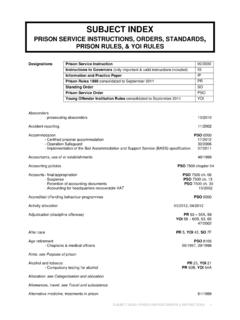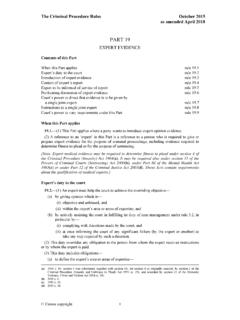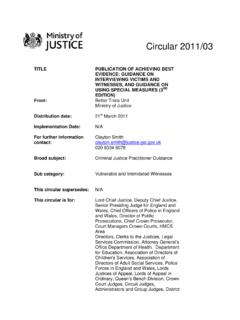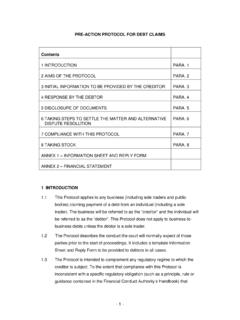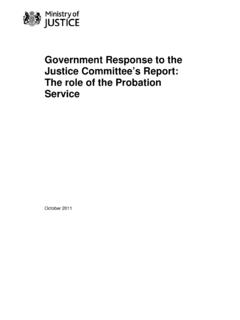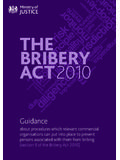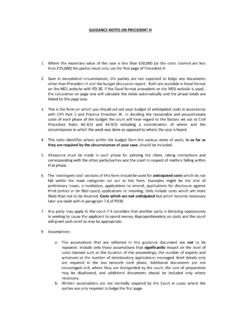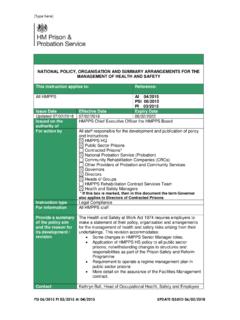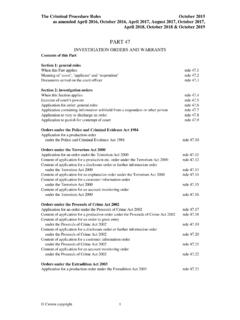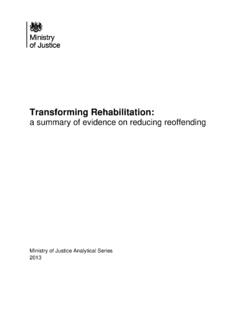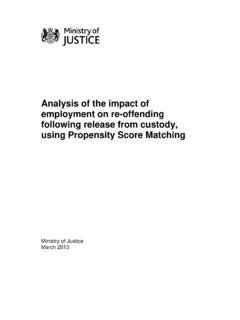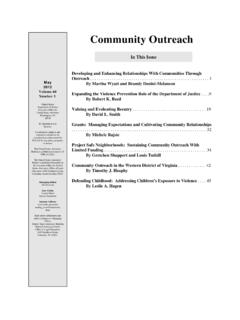Transcription of National Offender Management Service
1 0 National Offender Management Service PUBLIC PROTECTION MANUAL 2016 Edition Contents Chapter 1 Risk of harm 1 Chapter 2 Multi-Agency Public Protection Arrangements (MAPPA) 7 Annexes 19 Chapter 3 ViSOR 33 Annex 41 Chapter 4 Disclosure and Barring Service (DBS): the barred lists 43 Annexes 47 Chapter 5a Safeguarding and promoting the welfare of children 70 Chapter 5b Persons posing a risk to children (PPRC) 79 Annexes 83 Chapter 5c Child contact procedures 95 Annexes 103 Chapter 5d Personal photographs of children 119 Annex 123 Chapter 6 Harassment measures and no-contact requests 124 Annexes 130 Chapter 7 Sex Offender registration and notification 148 Annexes 155 Chapter 8 Terrorist notification requirements 179 Annexes 185 Chapter 9 Foreign National offenders 195 Chapter 10 Controlled materials 199 Annex 207 1 Chapter 1 RISK OF HARM 1 INTRODUCTION This guidance gives an overview of risk assessment and Management ; it aims to help prison staff assess an Offender s risk of serious harm.
2 It will be of particular interest to staff who: contribute to or attend Multi-Agency Public Protection Arrangements (MAPPA) meetings; contribute to and attend Multi-Agency Risk Assessment Conferences (MARAC); contribute to Inter-departmental Risk Management Team (IRMT) meetings in prisons; assess offenders for programmes, interventions, interactions and activities; engage in one-to-one work with offenders; work with offenders in a group setting; or contribute to decisions that require an assessment of risk. The central role in supervising offenders is undertaken by NOMS community-based Offender managers and prison-based Offender supervisors. However, all prison staff have a responsibility to contribute to the risk assessment and Management of each prisoner. Some staff will take a primary role, such as Offender supervisors and seconded probation staff; while others have a supporting role, such as personal officers, workplace supervisors, and education staff.
3 Good risk assessment and risk Management underpin all chapters of the Public Protection Manual and are relevant to every area of prison life. For more information, see the NOMS Risk of Harm Guidance and Training Resource and Supplement to Risk of Harm Guidance (2014). 2 WHAT IS RISK? Definition In general terms the criminal justice system has defined risk as: the risk of future re-offending & reconviction - the probability that an Offender / prisoner will offend, be arrested, and be reconvicted within two years; and the risk of serious harm - if reconvicted, the probability that the offence will be one of serious harm . Section 224 of the Criminal Justice Act 2003 defines serious harm (in the sentencing context, when determining whether an Offender presents a significant risk to the public of serious harm by the commission of further offences) as death or serious personal injury, whether physical or psychological.
4 The OASys risk assessment tool defines serious harm in more detail as an event which is life threatening and/or traumatic and from which recovery, whether physical or psychological, can be expected to be difficult or impossible . 2 The two dimensions of risk The risk of harm posed by offenders to others can be seen as having two key dimensions: the relative likelihood that an offence will occur; and the relative impact or harm of the offence - what exactly might happen, to what or whom, under what circumstances, and why. It is important to understand these two dimensions of risk. Some crimes (eg shoplifting) have relatively little impact or harm but, statistically, are the most common. Others (eg homicide) are rare but cause maximum damage. The level of risk The level of serious harm is defined by the likelihood of a serious harmful event happening.
5 The levels are: low: current evidence does not indicate a likelihood of causing serious harm; medium: there are identifiable indicators of serious harm. The Offender has the potential to cause such harm, but is unlikely to do so unless there is a change in circumstances - for example, failure to take medication, loss of accommodation, relationship breakdown, drug or alcohol misuse; high: there are identifiable indicators of serious harm. The potential event could happen at any time and the impact would be serious; very high: there is an imminent risk of serious harm. The potential event is more likely than not to happen as soon as the opportunity arises and the impact would be serious. Opportunity can include the removal or overcoming of controls, and changes in circumstances. Who is at risk? It is important to identify the person or groups of people who are specifically at risk; this allows resources and protective measures to be applied effectively.
6 Risk is categorised as risk to: the public: either generally or a specific group such as the elderly, vulnerable adults (for example, those with a learning disability), women or an ethnic minority group; a known adult: such as a previous victim or partner; prisoners: within a custodial setting; children: either specific children or children in general who may be vulnerable to harm of various kinds, including violent or sexual behaviour, emotional harm or neglect, or because they are in custody; staff: anyone working with the Offender , whether from Probation, the Prison Service , police or other agency (eg CARATs or health); self: the possibility that the Offender will commit suicide or self-harm. 3 3 RISK ASSESSMENT Risk assessment is a systematic process to analyse the static and dynamic risk factors relating to reconviction and risk of serious harm.
7 It is a continuous and evolving process. Ongoing assessment is an essential element of effective risk Management . It involves: accurate and reliable assessment of risk factors; day-to-day alertness to, and recording of, information relevant to the assessment of risk; and a formal review of that risk whenever indicated by an incident, significant further information, a policy requirement or the demands of a legal process. What does a risk assessment aim to do? A good risk assessment will help to: make a prediction of risk along both dimensions - likelihood and impact of harm; identify the likelihood of re-offending; identify the risk of harm (what harm and to whom?); and identify the key risk factors that led to the offence under consideration and that should be addressed to reduce the likelihood of further offending. Risk assessments should lead to risk Management plans that address the risk presented.
8 It is very important that a risk assessment is: fair, taking into account personal and situational factors that tend to increase risk and those that help to reduce risk; carried out by assessors who are alert to their own possible sources of bias; and carried out in an organisational context that supports fair and accurate risk assessment. Static and dynamic risk factors Risk factors are the conditions that increase the likelihood, frequency and length of offending behaviour and form the basis of all risk assessment. Risk factors can be broadly categorised as static or dynamic. Static factors cannot be changed or influenced and are based on historical events or characteristics such as the Offender s gender, age, offending history, and previous convictions. Dynamic risk factors relate to the attitudes, circumstances and behaviours that underpin or support offending.
9 They are subject to change and include substance misuse, associates and employment. Acute risk factors are those that can change quickly over days or hours. Their emergence indicates a period of critical risk in which serious offending is more likely than not to occur. Examples are increased levels of substance misuse, or the destabilisation of socio-economic factors such as loss of accommodation. Risk assessment tools The main approaches to risk assessment are clinical assessments based on professional judgement, actuarial assessment based on statistical predictions relating to groups of offenders, and holistic assessments that combine the two. 4 The table below outlines the main risk assessment tools routinely used by NOMS staff. All require training for them to be used properly; SARN, Risk Matrix 2000 and SARA require users to have completed accredited training as a condition of use.
10 Tool Description Used by OASys OASys is a structured, evidence-based risk assessment tool for adult (age 18+) offenders. It is used at pre-sentence report stage and during prison sentences (1 year plus), and most Community and Suspended Sentence Orders involving supervision or other rehabilitative requirements. It helps to assess offending-related needs and risk of serious harm, estimate the likelihood of violent and non-violent re-offending, and construct Risk Management and Sentence Plans. Assessments are reviewed periodically during the sentence. Offender managers, court report writers (probation) Offender supervisors (HMPS) Asset Asset is a structured assessment tool for young offenders who come into contact with the criminal justice system. It considers the offence and identifies factors that may have contributed to the offending behaviour.
